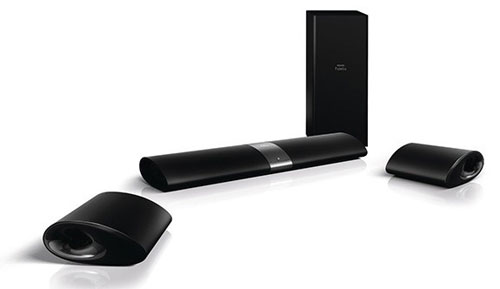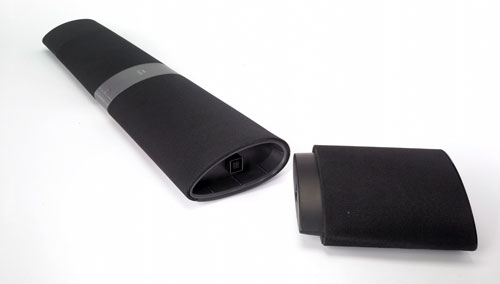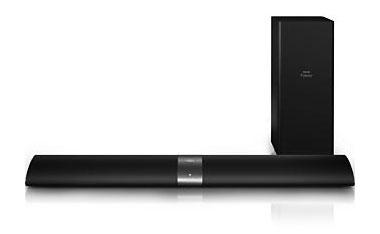Having been blown away by the HTL5120, we wondered whether the engineers at Philips can go one step further with its flagship Fidelio HTL9100 soundbar. Not content with just offering a wireless sub like other manufacturers, the HTL9100/12 also has two detachable speakers to give you a full surround sound experience. We’d be lying if we said we weren’t just a little bit excited about this one!

Design
The Philips HTL9100 carries a similar appearance to its cheaper cousin, the HTL5120. This is by no means a bad thing, as like the HTL-5120, the HTL-9100 looks gorgeous. The entire bar is again covered by a black cloth, with a striking brushed metal panel that graces the middle of the bar itself. The bar is not just for effect though, it houses an array of lights that indicate inputs, volume, and volume settings. Our only slight disappointment is that, as with the HTL5120, the more expensive HTL9100/12 doesn’t have an LED display panel.
The Fidelio HTL9100 can be placed flat or wall-mounted, and Philips say that both options will sound equally good, thanks to the Smart Equalisation feature that automatically detects how the soundbar is positioned, then adjusts the sound accordingly. We listened to the HTL9100 seated both flat and upright, and to our ears it sounded better when placed flat. We were relieved, as when placed upright the HDMI cables stuck out from the top which looked untidy.

The Philips’ real USP has to be those detachable wireless surround speakers. With the surround speakers attached, the HTL9100 operates like any other soundbar – however, when the surround speakers are detached you can then enjoy true decoded surround sound. Each surround speaker comes with 2-cell lithium polymer rechargeable batteries, which will give you ten hours of continuous playback, so unless you’re looking to watch back-to-back extended editions of Lord of the Rings you should be fine! Each surround speaker shares the same quality as the main unit with their wing-styled profile that oozes style. A single white LED light is present on each speaker to tell you when they’re charged, turning red when a charge is needed. Recharging is a breeze too, just plug the speakers back into the main unit, and recharge begins.

If that isn’t enough, the Philips HTL-9100 comes with its own wireless sub, which uses a proprietary SMSC 5.8GHz wireless audio system to provide robust connection and remove any chance of WiFi or Bluetooth network interference. The sub comes complete with a Philips patented feature called DoubleBASS technology. According to the company, this gives the perception of offering bass notes below the physical limit of the speaker. With its single 6.5-inch driver, we’ll be interested to see how this DoubleBASS feature works with bass-heavy soundtracks.
With all this talk of DoubleBASS technology we forgot to mention how great the Philips wireless subwoofer looks! What strikes us first is that it’s taller than the average sub at a height of 51cm. Don’t let this put you off though, as with its striking matt black finish, it’ll blend in nicely to most people’s living space. In fact, it looks so nice it might just be one sub you won’t want to hide away.
Connections
The Philips HTL9100/12 comes with AUX in, Digital coaxial in, Digital optical in, HDMI output (ARC), HDMI IN 1, HDMI IN 2, and Audio in (3.5mm). The sound bar also features integrated Bluetooth, allowing you to stream music from your smartphone, laptop, or other portable device, as well as onboard decoders for both Dolby Digital and DTS audio signals.
Setup
We set up our system identically to the Fidelio HTL5120, by connecting our Blu-ray player and set-top box via the two HDMI inputs, then took a single HDMI out into our HDTV. As the Philips supports HDMI with Audio Return Channel (ARC), if your TV is HDMI ARC compliant you can connect all media devices to your television, and output the audio to the soundbar via the HDMI (ARC) output. In terms of the wireless speakers and sub, that too was plain sailing, as each connected seamlessly as soon as the unit powered up.
Sound Quality
Before we get into sound quality, let’s have a look at what’s going on inside first. At the core of the Fidelio HTL9100 are high quality T1 class amplifiers providing 210 watts of total power – 120w from the bar itself, and 90w from the sub. Inside the soundbar are two 2.5-inch mid-range drivers and two 1-inch tweeters. Each wireless speaker also has its own 2.5” driver, but only acts as full range when detached from the main unit. When attached, each speaker is balanced to match the others, by way of a low-pass filter. DTS and Dolby decoding is handled by an onboard Cirrus Logic 32-bit DSP processor, which cleverly detects when the surround speakers are detached. Simply remove and relocate the wireless surround speakers, and the intelligent system automatically switches configuration to multi-channel mode, decoding 5.1 signals as true surround sound. So with all these, and let’s not forgot the DoubleBASS feature, we should be in for a sonic treat (at least we hope so).
So to start with, we wanted to see how the HTL-9100 handled 2.1 sound. We’ve again used the campus scene from The Incredible Hulk, as it has great surround activity as well as some thumping low-end which should prove particularly useful for the DoubleBASS test. The Philips needed some tweaking to get the best out of it, as at first the bass was too boomy, overpowering the front soundstage. It’s a shame that there’s no separate volume for the sub to get the blend spot-on, but by adjusting the overall bass control we were able to lose the boom but keep the bass nice and tight.
The virtual surround mode effect in 2.1 didn’t sound convincing, so we advise you against engaging it, but with the detachable speakers you shouldn’t need it anyway. With that thought in mind, we detached the surround speakers and played the same scene, and yes, we had real 5.1 sound – well 4.1 really, as the center channel becomes a virtual one once the surrounds are detached, but you’d be hard pressed to tell as dialogue is still clear and pronounced. Again, it’s a shame that there’s no separate volume for the surrounds, as they can in some instances be too loud, which distracts you from the front soundstage.
We ran some pink noise through the HTL9100/12 to try to test both the levels and Philips’ Smart Surround EQ technology. The company claims that this technology analyses and dynamically controls the sonic signals and levels in real time, to provide a well-balanced surround experience from all speakers in the system. With the pink noise engaged, we could hear this effect working with the surrounds. For instance, we set the main units volume to output at 75db which is what all home cinema setups should be calibrated to, and then played the same pink noise at the same volume through the surrounds. We could clearly hear a volume drop after a few seconds as the EQ kicked in to try to balance the sound. All in all, the Philips 9100 did an excellent job at balancing the volume levels of the surround speakers, with the meter level dropping only 4db to 71db. However, in real-world listening we found that the surrounds could still be on the loud side, so positioning is key. Simply moving the surrounds a few more feet away from our listening position cured this, and we were left with a fantastic sense of true decoded surround sound.
Next we wanted to test the DoubleBASS technology, and the Philips didn’t disappoint. Both the famous cannon scene from the Hulk and the Batwing alley scene in The Dark Knight Rises were handled superbly, with a deep low bass and not a rattle or vibration to be heard! Once we had the speakers’ position right and the EQ tweaked, the HTL9100 sounded fantastic. The soundbar handles music sources as well as it does movie soundtracks, owing to the wonderful high frequencies complemented by a great balance of mid- and low-end tones. If you feel the need, you can detach the surround speakers once again, and thanks to the Philips Dolby Pro Logic II decoding you can enjoy your music in surround sound. However, in our opinion the HTL-9100 sounded better with music sources in 2.1 mode with the surround speakers attached.
Conclusion
Philips have done it again in raising the sound bar (pardon the pun), by creating a product which is hard to fault – the HTL9100/12 is easily the best soundbar package we’ve tested so far. The detachable surround speakers are a marvel of engineering, and Philips’ DoubleBASS technology in the subwoofer creates a low-end bass response that sounds twice as big as it should for a sub of its size. With similar systems costing well over twice the price, the HTL9100 is a steal, and gets a fully deserved “Highly Recommended” rating from us.

